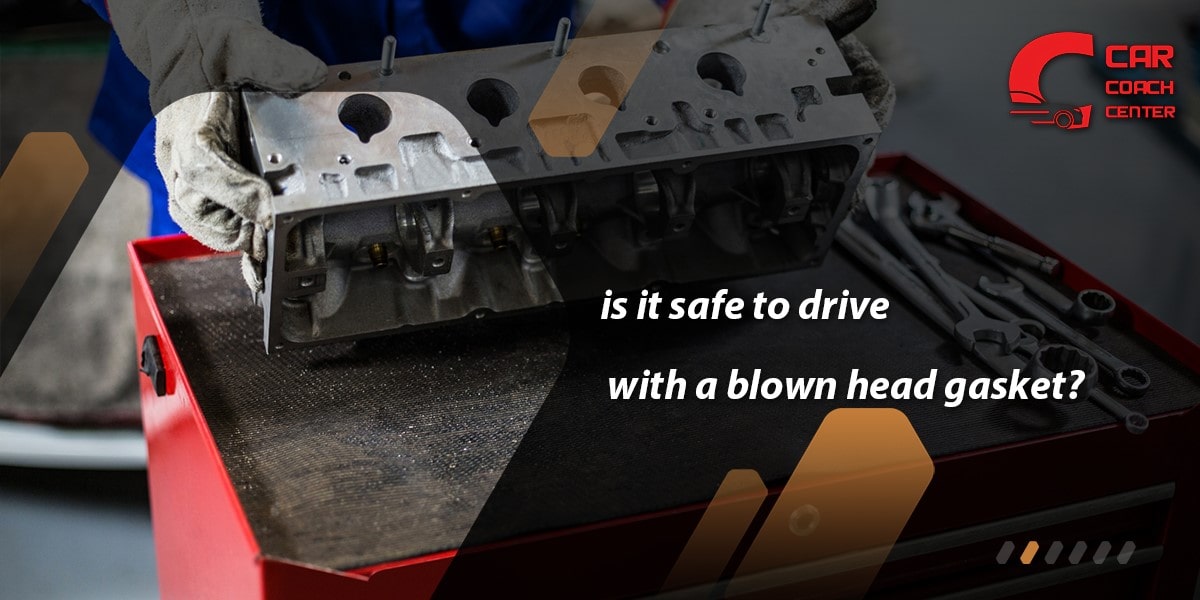Can You Drive A Car With A Blown Head Gasket
The head gasket is critical in any car’s engine, sealing the combustion chambers and preventing leaks between the cylinder head and the engine block. However, the head gasket can become compromised over time, leading to a blown head gasket. This issue is more than just an inconvenience; it can have severe consequences for both the vehicle and the driver.
In this article, we will explore whether it is possible to drive a car with a blown head gasket. We will explore the signs and symptoms of a compromised head gasket, the potential risks and damages associated with driving in such a condition, and the available repair options.

Additionally, we will provide preventive measures to avoid head gasket issues and highlight other common causes of similar symptoms. By understanding the implications of a blown head gasket and the steps to address it, you will be equipped to make informed decisions and ensure your vehicle’s longevity and optimal performance. So, let’s dive into the fascinating world of head gaskets and their impact on your car’s functionality.
The Telltale Signs: How to Identify a Blown Head Gasket
The head gasket plays a crucial role in properly functioning a car’s engine, and when it becomes compromised, certain signs and symptoms start to manifest. Understanding these telltale indicators can help you identify a potentially blown head gasket early on and take necessary actions.
One of the primary signs is an unusual loss of coolant. If you frequently add coolant to your vehicle without noticeable leaks, it could indicate that the head gasket is damaged, allowing coolant to escape into the combustion chambers. Another common symptom is the presence of white exhaust smoke. When the head gasket fails, it allows coolant to mix with the engine oil, resulting in white smoke visible from the exhaust pipe.
An overheating engine is a red flag for a blown head gasket. The compromised gasket disrupts the proper flow of coolant and can lead to engine overheating, often accompanied by a rise in the temperature gauge on the dashboard. Paying attention to these signs is important, as neglecting them can lead to more severe engine damage and costly repairs. If you notice any of these symptoms, having your vehicle inspected by a qualified mechanic is crucial to confirm the diagnosis and determine the best course of action.
Temporary Fixes: Can You Band-Aid a Blown Head Gasket?
Driving a car with a blown head gasket can have serious consequences, both for the vehicle and the driver. One of the most significant risks is engine damage. When the head gasket fails, it can allow coolant to mix with the engine oil. This mixture can lead to a loss of lubrication, causing excessive friction and heat buildup within the engine. Over time, this can severely damage engine components such as pistons, cylinders, and bearings, ultimately leading to engine failure.
Another consequence is coolant contamination. A blown head gasket can allow coolant to escape into the combustion chambers, mixing with the fuel and burning alongside it. This coolant combustion can release harmful gases and contaminants, potentially damaging the catalytic converter. The catalytic converter, responsible for reducing harmful emissions, may become clogged or fail altogether, leading to decreased engine performance and increased pollution.
Driving with a blown head gasket can also result in overheating of the engine. The compromised gasket disrupts the proper circulation of coolant, preventing it from effectively regulating engine temperature. Overheating can cause warped cylinder heads, damaged valves, and even cracks in the engine block, exacerbating the repair costs and rendering the engine inoperable.
Moreover, continued driving with a blown head gasket can worsen the initial damage, leading to more extensive repairs and increased expenses. Ignoring the issue can also jeopardize the safety of the driver and passengers if the engine fails unexpectedly on the road.
Given these potential risks and damages, promptly addressing a blown head gasket is crucial. Seeking professional assistance and arranging for the necessary repairs can prevent further harm to the engine and ensure the overall safety and reliability of the vehicle.

The Engine’s Heart: Understanding the Role of the Head Gasket
When faced with a blown head gasket, exploring the available repair options is essential to address the issue effectively. The most common and reliable solution for a blown head gasket is head gasket replacement. This involves removing the cylinder head, replacing the damaged gasket, and reassembling the components. It is a complex and labor-intensive repair typically performed by experienced mechanics. While head gasket replacement can be costly, it offers a long-term solution and ensures the engine’s proper functioning.
Alternatively, there are temporary solutions available, such as engine sealants. These sealants are chemical compounds designed to patch small leaks in the head gasket and temporarily restore its sealing properties. While they can be convenient for minor issues, it is important to note that engine sealants are not a permanent fix and should be a temporary measure to get the vehicle to a repair facility. It is crucial to follow the manufacturer’s instructions carefully when using sealants and consult a professional for guidance.
When considering repair options, weighing the pros and cons of professional repairs versus DIY approaches is important. While DIY repairs may seem cost-effective, having the necessary skills, tools, and knowledge to carry out the repair accurately is crucial. Improper repairs can lead to further damage and potential safety hazards. Seeking professional help ensures that the repair is performed correctly and efficiently, giving you peace of mind and minimizing the risk of complications.
Ultimately, the choice of repair option depends on factors such as the severity of the blown head gasket, budget constraints, and personal skill level. It is recommended to consult with a trusted mechanic or automotive professional to assess the situation, evaluate the repair options, and make an informed decision that best suits your needs and circumstances. Properly addressing a blown head gasket ensures the longevity and reliability of the engine, preventing further damage and costly repairs down the line.
Long Drives and Short Fuses: Risks of Driving with a Blown Head Gasket
Taking preventive measures is crucial to avoid the occurrence of a blown head gasket and maintain the health of your vehicle’s engine. By following these tips, you can minimize the risk of encountering this issue:
Regular Maintenance
Adhering to a routine maintenance schedule is vital. Regularly inspect your vehicle, following the manufacturer’s recommendations for service intervals. This includes checking and replacing fluids, filters, and worn-out components.
Coolant System Inspection
Keep a close eye on the coolant system. Ensure that the coolant levels are adequate and that there are no leaks. Additionally, monitor the condition of the coolant and follow the recommended coolant replacement intervals.
Avoiding Overheating
Preventing engine overheating is crucial for head gasket health. Avoid prolonged driving in high-temperature conditions and be cautious of any signs of overheating, such as an unusually high-temperature gauge reading or steam coming from the engine compartment.
Addressing Engine Issues Promptly
Be proactive in addressing any engine issues promptly. Problems such as overheating, coolant leaks, or rough idling should not be ignored, as they can contribute to head gasket failure. If you notice any abnormal signs or symptoms, have your vehicle inspected by a qualified mechanic as soon as possible.
Proper Installation
When replacing components in the engine, ensure they are installed correctly. Proper installation of parts such as the cylinder head, gasket, and bolts is crucial for maintaining a secure seal and preventing head gasket failure.
Avoiding Overworking the Engine
Avoid putting excessive stress on the engine. This includes avoiding aggressive driving, overloading the vehicle, and unnecessarily revving the engine. Excessive strain on the engine can contribute to premature wear and tear, increasing the risk of a blown head gasket.

DIY vs. Professional Repairs: Making the Right Choice
While a blown head gasket can cause specific symptoms, it’s important to know that similar signs can be attributed to other common issues in a vehicle’s engine. Understanding the differences between these causes can help you accurately diagnose the problem. Here are a few examples:
Intake Manifold Gasket Issues
The intake manifold gasket seals the connection between the intake manifold and the engine block. If this gasket fails, it can lead to symptoms similar to a blown head gasket, such as coolant leaks, rough idling, or engine misfires. However, the location of the issue differs, and addressing an intake manifold gasket problem requires specific repairs focused on that area.
Cracked Engine Block
A cracked engine block can produce symptoms that mimic those of a blown head gasket, including coolant leaks, overheating, and white exhaust smoke. The distinction lies in the root cause, as a cracked engine block typically results from severe overheating or engine stress. Repairing a cracked block is complex and costly, often involving engine replacement or major repairs.
Failed Water Pump
The pump circulates coolant throughout the engine. If the water pump fails, it can lead to engine overheating, coolant leaks, and other symptoms associated with head gasket issues. However, the repair approach differs, as replacing the water pump addresses the root cause rather than the head gasket itself.
Prevention is Key: Tips to Avoid Blown Head Gaskets
Maintaining the health of the head gasket is crucial for the longevity and optimal performance of your vehicle’s engine. Regular maintenance plays a significant role in preserving the integrity of the head gasket and preventing potential issues. Here are some key factors to consider:
Routine Inspections
Regularly inspecting the engine components, including the head gasket, is essential. A qualified mechanic can detect early signs of head gasket problems during routine check-ups, such as coolant leaks, oil contamination, or cylinder pressure irregularities. Identifying these issues early allows for prompt repairs, preventing further damage and potential engine failure.
Fluid Replacement Schedules
Follow the manufacturer’s recommendations for fluid replacements, including coolant and engine oil. Maintaining clean and properly functioning fluids helps prevent contamination contributing to head gasket failure. Regularly flushing and replacing coolant ensures its effectiveness in regulating engine temperature and preventing overheating.
Temperature Management
Proper temperature management is crucial for head gasket health. Avoid prolonged periods of overheating, as extreme temperature fluctuations can cause the head gasket to expand and contract excessively, leading to stress and potential failure. Regularly monitor the temperature gauge on your vehicle’s dashboard and promptly address any signs of overheating.
Avoiding Overworking the Engine
Excessive strain on the engine can contribute to head gasket problems. Avoid aggressive driving habits, excessive towing or carrying heavy loads, and extended periods of high-speed driving. Overworking the engine stresses the head gasket and other components, increasing the risk of failure.
Timely Repairs
If you suspect any issues with the head gasket or notice symptoms of a potential problem, seek professional assistance promptly. Ignoring the signs or delaying necessary repairs can exacerbate the issue, leading to more extensive damage and costly repairs. Timely repairs ensure that the head gasket remains in good condition and prevents further complications.
conclusion
In conclusion, a blown head gasket is a serious issue that can harm your vehicle’s engine and overall driving experience. By understanding the signs and symptoms of a blown head gasket, the potential risks and damages of driving with one, and the available repair options, you can make informed decisions to address the problem effectively.
Prioritizing preventive measures such as regular maintenance, coolant system inspections, and temperature management is crucial to avoid head gasket issues altogether. Additionally, awareness of other common causes of similar symptoms can help differentiate between engine problems and ensure accurate diagnosis and repairs.
By taking proactive steps and addressing head gasket issues promptly, you can maintain the health and longevity of your vehicle’s engine, ensuring reliable performance on the road. Remember, when it comes to the head gasket, prevention, timely repairs, and proper maintenance are key to avoiding costly repairs and keeping your vehicle running smoothly for years to come.
Read our comprehensive guide on CarCouchCenter.com to ensure your vehicle’s safety and optimal performance.
Can you drive a car with a blown head gasket?
It is not recommended to drive a car with a blown head gasket due to the potential risks and damages it can cause to the engine.
What are the signs of a blown head gasket?
Signs of a blown head gasket include coolant loss without visible leaks, white exhaust smoke, and engine overheating.
How can a blown head gasket be repaired?
The most common repair option for a blown head gasket is to replace it. Alternatively, temporary solutions like engine sealants can be used as a temporary fix.


